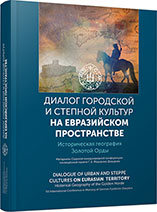Болгарский улус во второй половине XIII — середине XIV вв.: историко-археологический анализ
Bolgar Ulus in the Second Half of the 13th to Mid-14th Centuries: an historical and archaeological analysis
Author(s): Iskander Lerunovich Izmailov
Subject(s): History, Archaeology, Middle Ages, 13th to 14th Centuries
Published by: Издательский дом Stratum, Университет «Высшая антропологическая школа»
Keywords: Golden Horde; Bolgar Ulus; written sources; urban layout; trade; heyday; crisis
Summary/Abstract: The article addresses the flourishing period of the city of Bolgar after the Mongol conquest, as one of the leading economic and political centers of the Jochi Ulus. Numerous written records by Arabic and European authors and Russian chroniclers allow highlighting the general history of Bolgar in the Golden Horde period. Advantageous geographical position contributed to the rapid restoration of the city and the attainment of its capital status, as well as the further development of handicrafts and trade. Bolgar became one of the first centers of minting Golden Horde coins. According to archaeological data, the features of urban development were recovered. In the 14th century, the Cathedral mosque, administrative buildings, and mausoleums for distinguished persons were built in Bolgar. The decline of Bolgar in the second half of the 14th century was connected with the onset of the general political instability in the Jochi Ulus, the plague and the reduction of trade along the Great Silk road.
Book: Диалог городской и степной культур на Евразийском пространстве. Историческая география Золотой Орды
- Page Range: 113-117
- Page Count: 5
- Publication Year: 2016
- Language: Russian
- Content File-PDF

